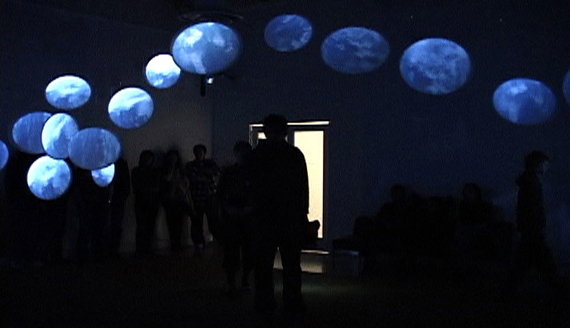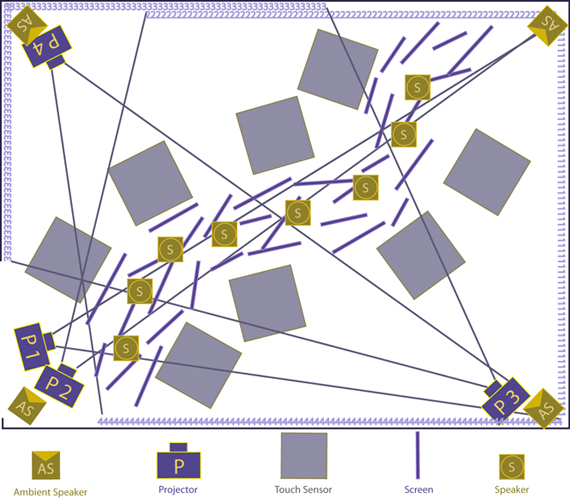One River (running...)
Interactive Installation, Media Diffusion: 6-channel audio and 32-channel video.
Commissioned by: Surrey Art Gallery
Supported by : Social Science and Humanities Research Council of Canada
School For the Contemporary Arts, Simon Fraser University
School of Interactive Arts + Technology, Simon Fraser University
One River (running) is an interactive spatial audio-visual installation, commissioned by Liane Davison from the Surrey Art Gallery and presented as a part of Surrey Seen Exhibit that celebrates the 30th anniversary of the Surrey Art Gallery. The exhibit is open from October 22 to December 18 2005. To celebrate its 30th anniversary, the Surrey Art Gallery has proposed a series of projects that invite artists to consider the City of Surrey as their theme. The collective title of all of these exhibitions is Surrey Seen. One River (running) is an image of community, both social and ecological, and is centered on a metaphor of river and flow. The river forms the backbone of the Fraser Valley from which a rich and complex ecology is nourished and provides the gateway for the great salmon runs that are increasingly imperiled in this region.

Upon entering the gallery, visitors face 32 ceiling hung, oval screens reflecting video images of speaking lips. Or visitors may see, projected on these screens and the four walls of the gallery, moving images from the natural environment. Small speakers, hidden in the ceiling, broadcast a symphony of voices and other sounds. Discretely placed under the carpet are pressure sensors. A web cam is barely visible, mounted in the ceiling. As visitors move through the gallery they influence their visual and sonic experience. For example, as visitors approach the screens their position may affect one of many simultaneous stories being spoken – it may become louder than the others.
The talking voices narrate stories about Surrey – its past, present and imagined future. Projected images of people’s mouths speak these words. Although the stories are mostly told in English, one may also hear many of the languages spoken by Surrey’s citizens. Stories may be
told from various cultural perspectives and spoken by children or elders.
Biographical information
The Computational Poetics Research Group, Aleksandra Dulic, Kenneth Newby and Martin Gotfrit, from Simon Fraser University in Vancouver, is developing a body of media performance techniques for the live performance of animation, music and sound design. Kenneth Newby is a media artist whose research and creative practice explores expressive applications of computer assisted media composition, performance and diffusion. He teaches new media composition and technique. Aleksandra Dulic is a media artist and theorist working in the area of interactive computer animation with current research underway in performative visualization of sound and music. Martin Gotfrit's research centres on the creation, performance and function of music and sound in many different disciplines and contexts. He is the Director os the School for the Contemporary Arts at Simon Fraser University. Together the three authors of this work have been working together as the Computational Poetics Research Group for the past four years.
Credits
Computational Poetics Research group
Aleksandra Dulic, Kenneth Newby, Martin Gotfrit
with Dinka Pignon
Production Team:
Alex Mateesco: sound recording and editing
Phil Thomson: sound editing and design
Milena Droumeva: sound recording
So-Young Park: animation
Layda Gongora: animation assistance
Derek Robinson: physical interaction design
Media Diffusion
One River (running...) was composed using a media diffusion system to enable the accurate spatialization of video imagery. The visual components are assembled in a virtual space using the OpenGL graphics library. Images in the form of stills or movies can be shaped with animated alpha masks and placed with extreme precision in the exhibition space to avoid projector spill on other screens or non-projection surfaces. Presets can be stored and interpolated to allow images to change position. In addition a number algorithms are available for the animation images in arbitrary paths through the space and piloting images on paths among the screens. Each diffusion point is a 3D object and can be effectively positioned, scaled, rotated, blended, textured, motion blurred, etc.
The virtual screens the images are placed on can be thought of as a set of diffusion points on which any single image or composite can be projected. This work was inspired by earlier research in audio diffusion which demonstrated the effectiveness of a large number of uncorrellated sound sources in facilitating an experience of immersion. When applied to the visual domain the same enhancement of immersion occurs as a result of the independence of each diffusion point and it's placement in the space of the exhibition. The media diffusion system effectively allows the media designer to break away from the flat, two dimensional nature of traditional screen projections. The composite image becomes spatial and engages in a sculptural dialogue with its enclosing space.
An audio diffusion system has been developed to complement the visual media diffusion system described above. The whole system is in a prototype stage as it was developed for the One River (running...) installation.

